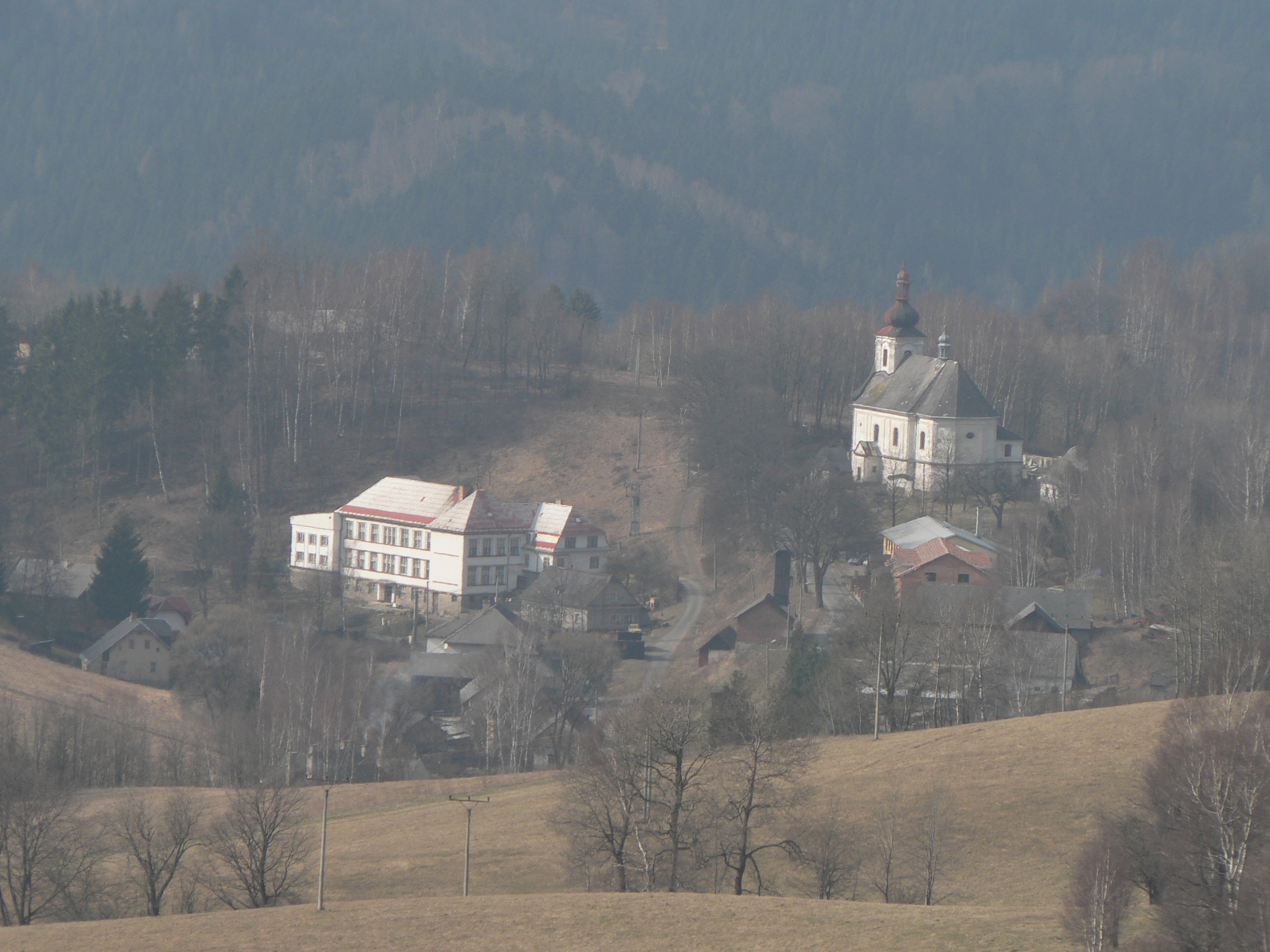|
Pusté Žibřidovice
Pusté Žibřidovice () is a village and administrative part of Jindřichov in Šumperk District in the Olomouc Region of the Czech Republic The Czech Republic, also known as Czechia, and historically known as Bohemia, is a landlocked country in Central Europe. The country is bordered by Austria to the south, Germany to the west, Poland to the northeast, and Slovakia to the south .... Etymology Very original name was Seyfersdorf which means Seyfer's village. The name later evolved into Seibersdorf. From 15th century, the place is called Wüst Seibersdorf where the adjectivum "wüst" means "deserted", the village was probably plundered by Hungarian soldiers during Bohemian War. Czech name is a loan translation. History The village was probably founded by German settlers. The first note comes from 1382. German citizens were expulsed after WWII and the area was repopulated by Czech people. In 1949, Pusté Žibřidovice has lost its autonomy and was attached to Jindřichov. ... [...More Info...] [...Related Items...] OR: [Wikipedia] [Google] [Baidu] |
Jindřichov (Šumperk District)
Jindřichov () is a municipality and village in Šumperk District in the Olomouc Region of the Czech Republic. It has about 1,100 inhabitants. Administrative division Jindřichov consists of four municipal parts (in brackets population according to the 2021 census): *Jindřichov (697) * Habartice (68) *Nové Losiny (124) * Pusté Žibřidovice (155) Etymology The municipality is named after Heinrich (Czech: Jindřich) Kaiser, the second owner of the local paper mill. Geography Jindřichov is located about north of Šumperk and north of Olomouc. The southwestern part of the municipal territory with the built-up area lies in the Hanušovice Highlands. The northeastern part of extends into the Hrubý Jeseník mountain range and includes the highest poin of Jindřichov, a contour line below the summit of the Vozka mountain at above sea level. The village of Jindřichov is situated in a narrow valley of the Branná River. The nearby landscape is composed of coniferous forests, st ... [...More Info...] [...Related Items...] OR: [Wikipedia] [Google] [Baidu] |
Šumperk District
Šumperk District () is a Okres, district in the Olomouc Region of the Czech Republic. Its capital is the town of Šumperk. Administrative division Šumperk District is divided into three Districts of the Czech Republic#Municipalities with extended competence, administrative districts of municipalities with extended competence: Šumperk, Mohelnice and Zábřeh. List of municipalities Towns are marked in bold: Bludov (Šumperk District), Bludov - Bohdíkov - Bohuslavice (Šumperk District), Bohuslavice - Bohutín (Šumperk District), Bohutín - Branná - Bratrušov - Brníčko - Bušín - Chromeč - Dlouhomilov - Dolní Studénky - Drozdov (Šumperk District), Drozdov - Dubicko - Hanušovice - Horní Studénky - Hoštejn - Hraběšice - Hrabišín - Hrabová (Šumperk District), Hrabová - Hynčina - Jakubovice - Janoušov - Jedlí - Jestřebí (Šumperk District), Jestřebí - Jindřichov (Šumperk District), Jindřichov - Kamenná (Šumperk District), Kamenná - Klopina - Kolšov ... [...More Info...] [...Related Items...] OR: [Wikipedia] [Google] [Baidu] |
Olomouc Region
Olomouc Region (; , ; ) is an administrative unit () of the Czech Republic, located in the north-western and central part of its historical region of Moravia (''Morava'') and in a small part of the historical region of Czech Silesia (''České Slezsko''). It is named for its capital Olomouc. Olomouc region borders with the Moravian-Silesian Region (in the east), Zlín Region (in the south-east), South Moravian Region (in the south-west) and Pardubice Region (in the west). Furthermore, the region shares a 104 km long border with Poland (in the north). Administrative divisions The Olomouc Region is divided into 5 districts: On the territory of the region there are 13 administrative districts of municipalities with extended powers and 20 administrative districts of municipalities with authorized local authority. Population In January 2024 the population of the Olomouc Region totalled 632,864 inhabitants. As of 2019, 50.3% of region's population lived in municipalities with ... [...More Info...] [...Related Items...] OR: [Wikipedia] [Google] [Baidu] |
Czech Republic
The Czech Republic, also known as Czechia, and historically known as Bohemia, is a landlocked country in Central Europe. The country is bordered by Austria to the south, Germany to the west, Poland to the northeast, and Slovakia to the southeast. The Czech Republic has a hilly landscape that covers an area of with a mostly temperate Humid continental climate, continental and oceanic climate. The capital and largest city is Prague; other major cities and urban areas include Brno, Ostrava, Plzeň and Liberec. The Duchy of Bohemia was founded in the late 9th century under Great Moravia. It was formally recognized as an Imperial Estate of the Holy Roman Empire in 1002 and became Kingdom of Bohemia, a kingdom in 1198. Following the Battle of Mohács in 1526, all of the Lands of the Bohemian Crown were gradually integrated into the Habsburg monarchy. Nearly a hundred years later, the Protestantism, Protestant Bohemian Revolt led to the Thirty Years' War. After the Battle of White ... [...More Info...] [...Related Items...] OR: [Wikipedia] [Google] [Baidu] |
Bohemian War (1468–78)
The Hussite Wars, also called the Bohemian Wars or the Hussite Revolution, were a series of civil wars fought between the Hussites and the combined Catholic forces of Sigismund, Holy Roman Emperor, Holy Roman Emperor Sigismund, the Papacy, and European monarchs loyal to the Catholic Church, as well as various Hussite factions. At a late stage of the conflict, the Utraquists changed sides in 1432 to fight alongside Roman Catholics and opposed the Taborites and other Hussite factions. These wars lasted from 1419 to approximately 1434. The unrest began after pre-Protestant Christian reformer Jan Hus was executed by the Catholic Church in 1415 for heresy. Because Sigismund had plans to be crowned the Holy Roman Emperor (requiring papal coronation), he suppressed the religion of the Hussites, yet it continued to spread. When King Wenceslaus IV of Bohemia, brother of Sigismund, died of natural causes a few years later, the tension stemming from the Hussites grew stronger. In Prague ... [...More Info...] [...Related Items...] OR: [Wikipedia] [Google] [Baidu] |

